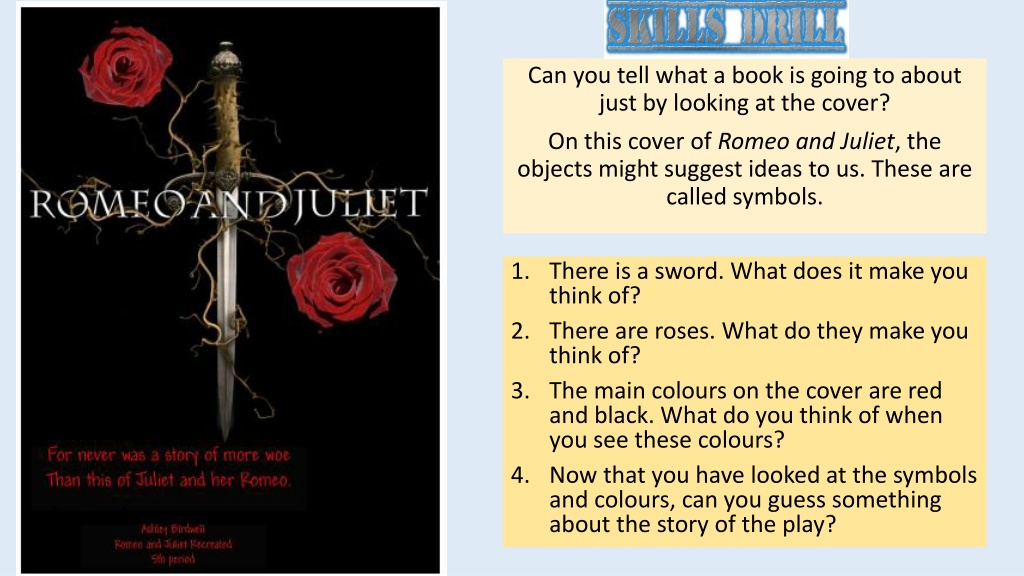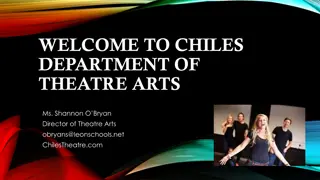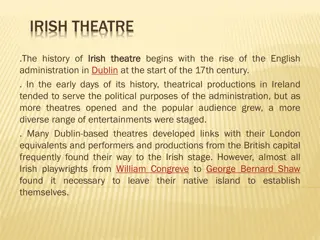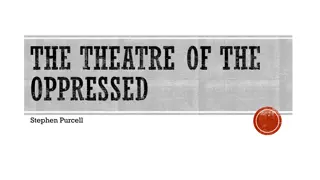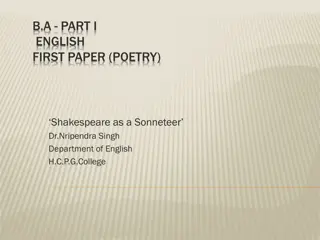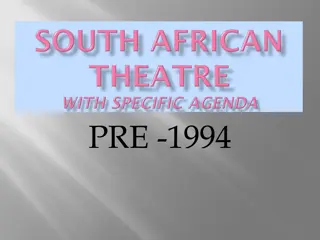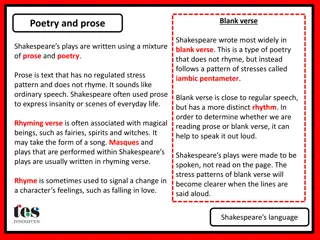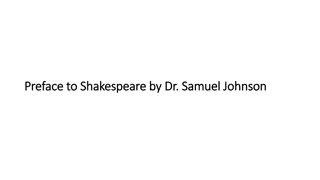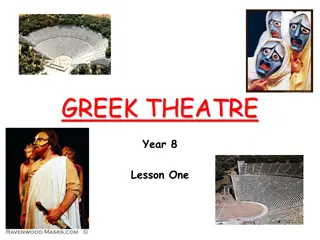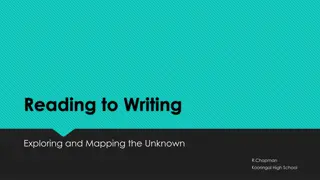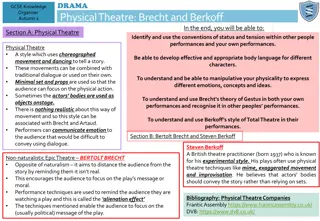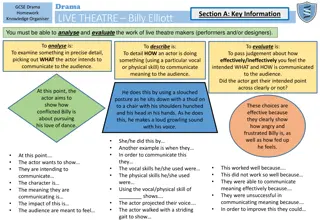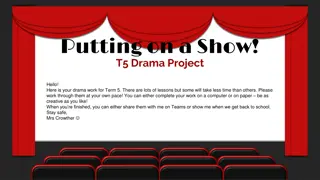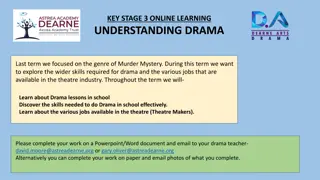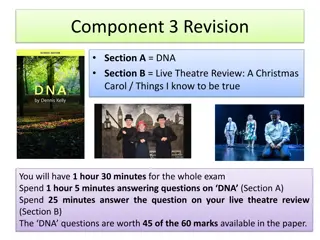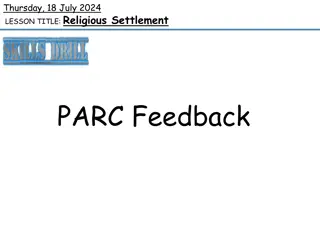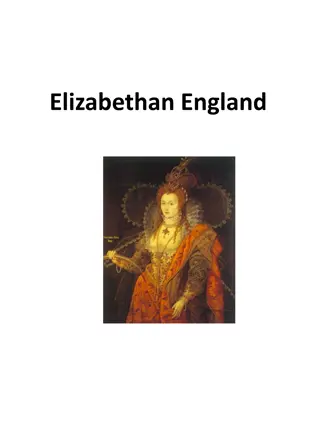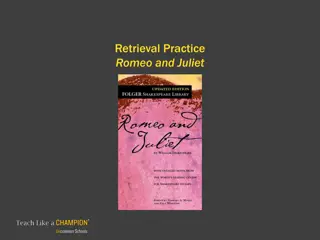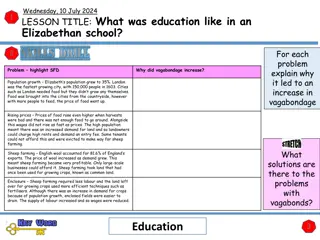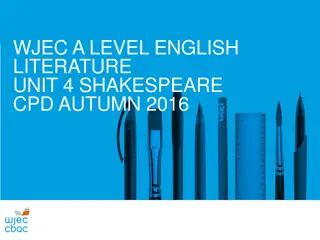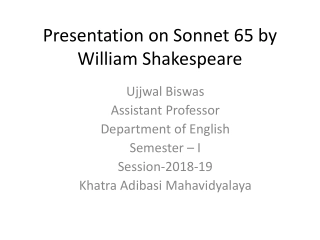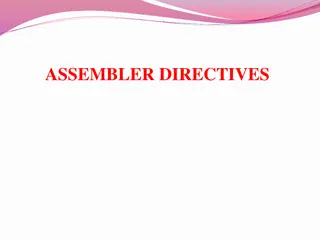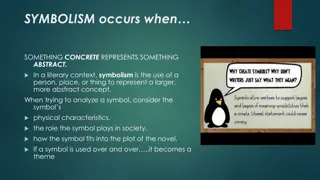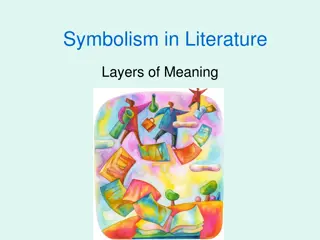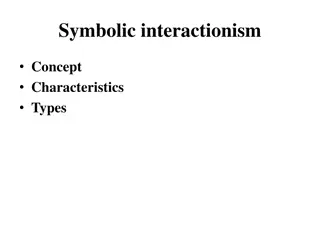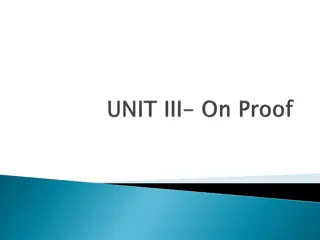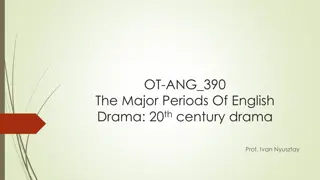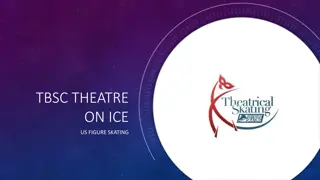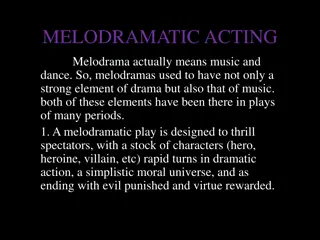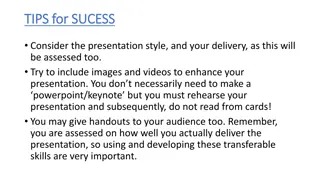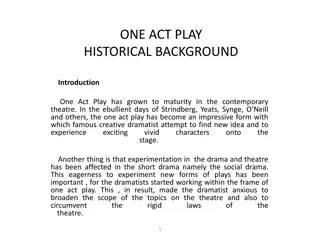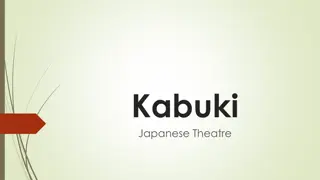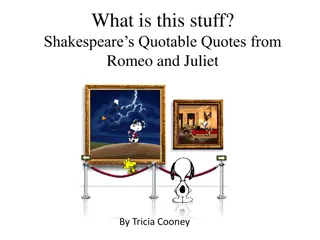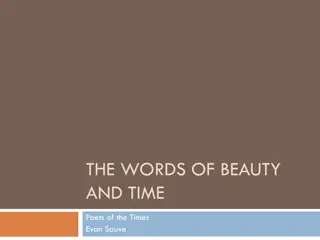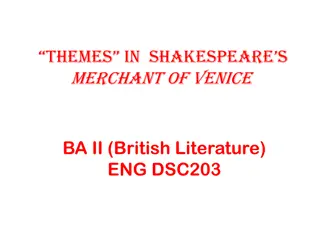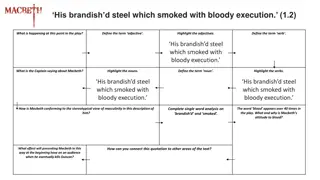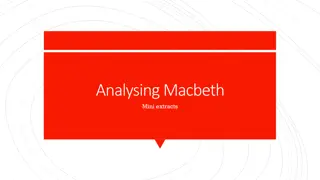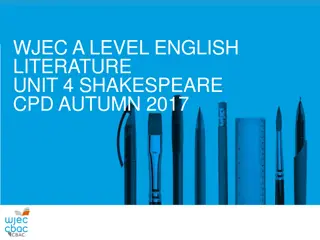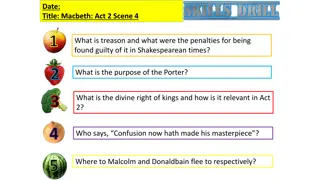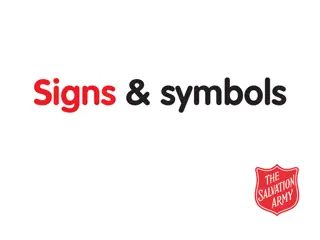Symbols and Facts: Uncovering Shakespeare and Elizabethan Theatre
The analysis begins by exploring the symbols present on the cover of "Romeo and Juliet" such as the sword and roses. It then delves into distinguishing facts from opinions regarding Shakespeare's life, touching on key events like his baptism, marriage, and career. Additionally, it provides insights into the experiences of an Elizabethan theatre-goer, detailing aspects like playtimes, costs, and the theatrical environment.
Download Presentation

Please find below an Image/Link to download the presentation.
The content on the website is provided AS IS for your information and personal use only. It may not be sold, licensed, or shared on other websites without obtaining consent from the author. Download presentation by click this link. If you encounter any issues during the download, it is possible that the publisher has removed the file from their server.
E N D
Presentation Transcript
Can you tell what a book is going to about just by looking at the cover? On this cover of Romeo and Juliet, the objects might suggest ideas to us. These are called symbols. 1. There is a sword. What does it make you think of? 2. There are roses. What do they make you think of? 3. The main colours on the cover are red and black. What do you think of when you see these colours? 4. Now that you have looked at the symbols and colours, can you guess something about the story of the play?
Fact or Opinion? We can be sure of facts. We cannot be sure of opinions. Opinions are what some people think or believe are true, but no-one can be sure that they are right. Facts are true, and we can prove it.
Who was Shakespeare? Sort out the FACTS from the OPINIONS. We think that Shakespeare was born in 1564. We know he was baptized in Stratford-Upon- Avon. He may have gone to school in Stratford. Some people believe that he left school to help his father with his business. He got married in 1582 to Anne Hathaway. They had three children. We know he went to London. Some people say that he had to leave Stratford because he had stolen a deer! We are certain that he was an actor. We don t know for sure what theatre company he worked in. We know that he owned part of a theatre called The Globe. We know that he wrote lots of plays and poems. He died in 1616 He is buried in a church in Stratford. On his gravestone, there are words that put a curse on anyone who moves his body.
ANSWERS ANSWERS FACTS OPINIONS. We know he was baptized in Stratford-Upon- Avon. He got married in 1582 to Anne Hathaway. They had three children. We know he went to London. We are certain that he was an actor. We know that he owned part of a theatre called The Globe. We know that he wrote lots of plays and poems. He died in 1616 He is buried in a church in Stratford. On his gravestone, there are words that put a curse on anyone who moves his body. We think that Shakespeare was born in 1564. He may have gone to school in Stratford. Some people believe that he left school to help his father with his business. Some people say that he had to leave Stratford because he had stolen a deer! We don t know for sure what theatre company he worked in.
Interviewing an Elizabethan theatre goer. Match the questions to the answers. Match the questions to the answers. 1. How did you know that a play was about to begin? What time did a play usually start? How much did it cost to get in? Did you have stand in the pit all the time? Was there any scenery? What were the costumes like? How did you know when a scene ended if there was no curtain? How did you know what time the play was set if it always started at the same time? A. B. A play had to take place during the day, usually at 2 o clock. The costumes were beautiful. One was a velvet cloak with silver and gold on it. There was no curtain, so you listen for rhyming lines. They are called rhyming couplets. When they were said, the actors left the stage and the scene ended. There were bits of scenery like a few chairs. We looked for a flag above the theatre and knew a play would be about to start. We paid a penny to go in and stand in the pit around the three sides of the stage. For another penny you could have a seat under the thatched roof. We stood in the pit all the time, although you could walk about and leave for a bit if you got bored and then come back later. You knew if it was set at night because the actors would talk about the moon. If it was daytime they would mention the sun. 2. C. 3. 4. D. E. 5. 6. 7. F. G. 8. H.
ANSWERS 1. E. We looked for a flag above the theatre and knew a play would be about to start. How did you know that a play was about to begin? 5. D. Was there any scenery? There were bits of scenery like a few chairs 6. B The costumes were beautiful. One was a velvet cloak with silver and gold on it. What were the costumes like? 2. A. A play had to take place during the day, usually at 2 o clock. What time did a play usually start? 7. How did you know when a scene ended if there was no curtain? C. There was no curtain, so you listen for rhyming lines. They are called rhyming couplets. When they were said, the actors left the stage and the scene ended. 3. How much did it cost to get in? F. We paid a penny to go in and stand in the pit around the three sides of the stage. For another penny you could have a seat under the thatched roof. 4. Did you have stand in the pit all the time? G. We stood in the pit all the time, although you could walk about and leave for a bit if you got bored and then come back later. 8. How did you know what time the play was set if it always started at the same time? H. You knew if it was set at night because the actors would talk about the moon. If it was daytime they would mention the sun.
What is Romeo and Juliet about? Romeo and Juliet is a play, written by William Shakespeare, that explores the themes of love and conflict. The play was written in 1595 during the Elizabethan era. The play tells the story of two young people from warring families who fall in love.
Prologue Prologue: A separate introductory section of a literary dramatic or musical work. The Prologue in Romeo and Juliet is the first part of the text to be performed. It is performed by the Chorus. This is a storyteller or narrator rather than a character. The Prologue is packed with information and summarises the whole story by revealing several plot twists.
Which of these ARE features of the Prologue? It is a summary of the main story of the play. It is focused on one event from the story. It is performed by the Chorus . It is performed by the protagonist (main character). It keeps all the details of the story a secret from the audience. It occurs at the beginning of the text. It occurs at the end of the text. It reveals lots of twists in the plot.
ANSWERS: It is a summary of the main story of the play. It is performed by the Chorus . It occurs at the beginning of the text. It reveals lots of twists in the plot.
The Prologue [Enter Chorus] Two households, both alike in dignity, In fair Verona (where we lay our scene), From ancient grudge break to new mutiny, Where civil blood makes civil hands unclean. From forth the fatal loins of these two foes A pair of star-cross d lovers take their life; Whose misadventured piteous overthrows Doth with their death bury their parents strife. The fearful passage of their death-marked love And the continuance of their parents rage, Which, but their children s end nought could remove, Is now the two hours traffic of our stage; The which if you with patient ears attend, What here shall miss, our toil shall strive to mend [exit]
The Prologue Two households, both alike in dignity, In fair Verona (where we lay our scene), Glossary: Households = a family group Dignity worthy of honour or respect
From ancient grudge break to new mutiny, Where civil blood makes civil hands unclean. Glossary: Grudge: a continued feeling of anger towards something Mutiny: uprising or rebellion Civil: relating to ordinary citizens
Copy the TRUE statements: The Prologue introduces the setting of Verona. The main characters have been mentioned. Verona is a nice place to live. The setting doesn t seem safe.
ANSWERS: The Prologue introduces the setting of Verona. The setting doesn t seem safe.
From forth the fatal loins of these two foes A pair of star-cross d lovers take their life; Glossary: Fatal: causing death Foes: enemies
Whose misadventured piteous overthrows Doth with their death bury their parents strife. Glossary: Misadventured : unfortunate mistake Strife: angry disagreement
Copy the TRUE statements: Star-crossed lovers and their parents are introduced in the Prologue. A group of friends and a rival gang are introduced in the Prologue. The star-crossed lovers run away from home. The star-crossed lovers break up after an argument. The star-crossed lovers commit suicide. At the end, the city of Verona is destroyed. At the end, the parents abandon the star-crossed lovers. At the end, the families stop fighting.
ANSWERS: Star-crossed lovers and their parents are introduced in the Prologue. The star-crossed lovers commit suicide. At the end, the families stop fighting.
The fearful passage of their death-marked love And the continuance of their parents rage, Which, but their children s end nought could remove, Glossary: Passage: journey Nought: nothing
Is now the two hours traffic of our stage; The which if you with patient ears attend, What here shall miss, our toil shall strive to mend Glossary: Toil: work hard Strive: make great effort
Copy the TRUE statements. The play will last for 1 hour. The play will last for 2 hours. The audience will be asked to learn from the play The audience will be asked to listen patiently and carefully.
ANSWERS: The play will last for 2 hours. The audience will be asked to listen patiently and carefully.
Advertising Design a board that an actor might carry to say that Romeo and Juliet was about to begin. OR Draw the flag that might be raised above the theatre to advertise that Romeo and Juliet is about to be performed.
What knowledge have you learnt today? What skills have you learnt/developed today? How has your previous learning helped you today?
